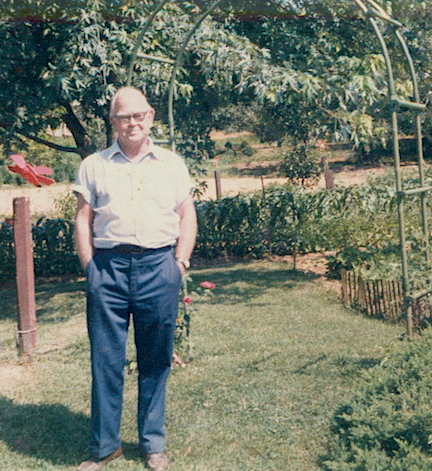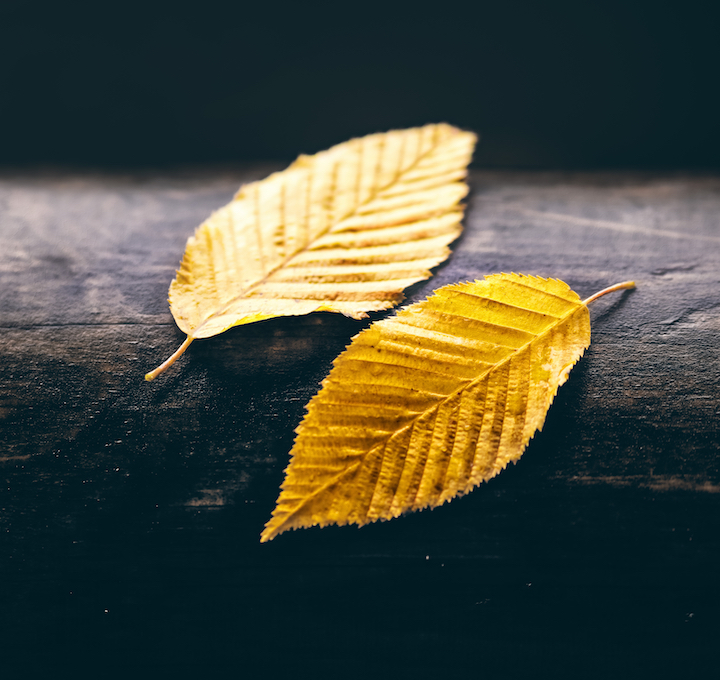A Journey for Justice—and Understanding
A poet joins the NAACP march in Ferguson, Missouri, and learns he was wrong about the role of race in this country
“Andrew. Andrew! Wake up, man. We gotta roll.” I peel open my eyes to find NAACP Regional Field Organizer Jonathan McKinney standing over me in the dark gymnasium of Lincoln University. “Take this,” he says, handing me a cup of coffee. “Get the Michigan boys up. The DOJ is waiting.”
 For a moment I have no idea what Jonathan is talking about. During the past five days, I’ve slept less than fifteen hours, and my calves are on fire after marching more than a hundred miles—from the site of Michael Brown’s death in Ferguson, Missouri, all the way to the Gasconade River just west of Rosebud, where yesterday all of us on the NAACP’s “Journey for Justice” survived a harrowing march through town.
For a moment I have no idea what Jonathan is talking about. During the past five days, I’ve slept less than fifteen hours, and my calves are on fire after marching more than a hundred miles—from the site of Michael Brown’s death in Ferguson, Missouri, all the way to the Gasconade River just west of Rosebud, where yesterday all of us on the NAACP’s “Journey for Justice” survived a harrowing march through town.
Then I remember.
Last night we heard that the Ku Klux Klan was planning to block our passage across the Gasconade River at Highway 50—a reminder of attacks on Selma marchers at the Edmund Pettis Bridge nearly fifty years ago. But Jonathan and NAACP Southeast Regional Field Director Kevin Myles have a plan: five “sprinters” (marchers who can sustain a four-mile-per-hour pace) will meet representatives from the U.S. Department of Justice at the river before daybreak and cross the bridge well before the Klan has finished its morning coffee. The rest of the marchers will join us once the coast is clear.
Only Jonathan and I, the Michigan boys (Randy Chabot, Phil Dage, Max Harris), and the DOJ know the plan. We know a KKK mole has joined our journey, but we can’t be sure he’s the only one. Only thirty-five miles from our goal of Jefferson City, we can’t suffer any more setbacks like the one in Rosebud. We have an appointment with the Missouri state capital to keep. I leap from my sleeping bag and down the hot coffee as I lace up my sneakers. I check my phone. Five a.m. on the dot.
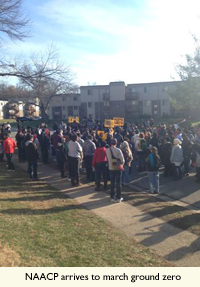 Hours later, I spot a KKK tracker—a short, rotund woman who’s been following the march for the past few days, snapping photos of us and feigning support. “Morning,” she says with a smile.
Hours later, I spot a KKK tracker—a short, rotund woman who’s been following the march for the past few days, snapping photos of us and feigning support. “Morning,” she says with a smile.
At first I say nothing. We’ve been instructed by NAACP President Cornell Brooks to keep our silence. So far I’ve followed orders, but this time I can’t help it: “Howdy,” I say. “Looks like you folks showed up a little late this morning.”
Instantly her face turns red. We walk on through the dusk, our fellow marchers waiting for us just up the road.
I first heard about the NAACP’s “Journey for Justice: Ferguson to Jefferson City” on Thanksgiving morning when I was checking Facebook. On a whim, I searched flights from Denver, where I live, and St. Louis. To my surprise, I found a direct flight for under $200. Even thinking about it felt a little reckless. I’m an adjunct professor and freelance editor, and my wife is in graduate school. I could barely afford the plane ticket, let alone any expenses I might incur on the road.
Then it dawned on me: I had published my first book of poetry in March and it has been doing pretty well. I could use the profits to fund the journey. I’ve always felt a little guilty for indulging in poetry, something that rarely affects social change despite most poets’ insistence that it can. Here was an opportunity to do exactly that. I bought the ticket and began searching for more information about the march.
There wasn’t much. It would launch from the Canfield Apartments, where Michael Brown was shot and killed on August 9 by Ferguson, Missouri, police officer Darren Wilson and would end, somehow, in the state capital. No route was available on the NAACP website. I had no idea where I would sleep or what I would eat.
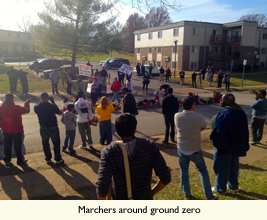 When my wife got home, I told her my plans anyway. She gave me a high five, and we got to packing.
When my wife got home, I told her my plans anyway. She gave me a high five, and we got to packing.
By the time I arrived in St. Louis the next day, the NAACP site had been updated, and I registered for the march. Armed with a bed roll, sleeping bag, and a single change of clothes, I made it to Ferguson at nine a.m. on Saturday. I was shocked to find that the street where Brown’s body had been left for four hours was barely wide enough for two cars, the site of his death less than twenty feet from a residential building. It was hard to fathom that such a horrific event had occurred so close to homes and on such a small, untrafficked street.
That morning people slowly began arriving by the dozens to pay their respects to Brown and join the march. One black demonstrator denounced the shooting and argued the importance of “hitting them where it hurts—their money.” Another young black man, a guy named Sam who lives in the apartment closest to the memorial, said the rioters were fools to have burned down their own buildings but argued that the media would have ignored them otherwise. I would soon learn just how right Sam was.
At one point a group of about 300 motorcyclists stopped all traffic on Canfield Drive and called for a moment of silence. A man played a trombone over the exact spot where Brown died. When a Beemer showed up carrying four black leaders wearing fancy duds, the media swarmed them, but several of the residents booed. “Where the fuck have you been?!” they yelled. “We’ve been dying here for years, and you show up now?”
 By midafternoon, I was marching north with a group of five or six hundred people on West Florissant Street, past boarded-up restaurants and burned-out gas stations. Six hours and ten miles later, we had made it to the outskirts of St. Louis County and devoured baked chicken and green beans in the basement of the Washington Metropolitan AME Zion Church.
By midafternoon, I was marching north with a group of five or six hundred people on West Florissant Street, past boarded-up restaurants and burned-out gas stations. Six hours and ten miles later, we had made it to the outskirts of St. Louis County and devoured baked chicken and green beans in the basement of the Washington Metropolitan AME Zion Church.
I learned that Washington Metropolitan would be our base of operations for the first half of the week. The plan was to wake each morning at six a.m., return by bus to our last stopping point, and march approximately twenty-five miles per day; then the bus would return us to the church to sleep. On Thursday, we’d shift our base to the Quinn Chapel AME Church in Jefferson City, from which we would make our final push for the capital. We would all—the marchers and the NAACP president alike—would sleep in church pews or on the floor. Showers would be rare. Breakfast, lunch, and dinner would be provided. A bus would follow close behind all day, there to spell exhausted marchers and provide protection if need be.
That first night I was struck by how kind my fellow marchers were. Without hesitation they took me in, fed me, housed me, and even gave me a ride to the Ferguson police station after I gave up on falling asleep that night and decided to join the protestors instead.
The scene on South Florissant Street was chaotic.
National Guardsmen armed with M4s, Ar-15s, and Remington 870 shotguns lined the streets, the bright-white probes of their armored vehicles spinning like frantic lighthouse beacons. Outside the police station, well over a hundred state and local law-enforcement officers in full riot gear lined the sidewalk. I joined a group of fifteen activists donning ski goggles and tactical gloves. They’d driven a van from Denver to Ferguson; their plan was a little different from the NAACP’s. I was torn: should I join them and face off with police, or should I return to the church and try to catch some sleep before marching twenty-five miles the next morning?
In the end, I entered the fray.
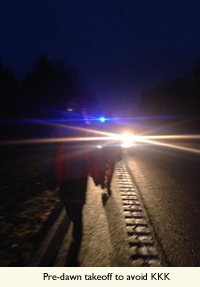 To my surprise, the jeers of the crowd went unanswered by law-enforcement officers. They arrested no one. They projected no long, thin arcs of tear gas into the crowd. Despite all the anger and unrest, it seemed protestors and law enforcement had found a way to get along. We stayed on our side of the riot barrier, they stayed on theirs, and the protest remained peaceful.
To my surprise, the jeers of the crowd went unanswered by law-enforcement officers. They arrested no one. They projected no long, thin arcs of tear gas into the crowd. Despite all the anger and unrest, it seemed protestors and law enforcement had found a way to get along. We stayed on our side of the riot barrier, they stayed on theirs, and the protest remained peaceful.
We dispersed around 2 a.m., and I thumbed it back to the church to rejoin the snoring marchers. Next thing I knew, I was singing spirituals I’d heard only in movies and chanting along to lyrics written by fellow marcher Tim Swain: “We are the warriors, the justice warriors.”
As we marched, my heart was soaring. I’d arrived in Ferguson with no sense of what I was doing or how exactly my presence there would make any difference. After just a few hours with the NAACP, I was grateful I’d trusted my instincts on Thanksgiving afternoon. I’d found my crew.
The first four days of the march followed the same pattern: early in the day we were met by friendly honks and thumbs-up signs; new marchers joined us; locals brought us coffee, hand warmers, orange vests, and the like. But later in the day it was all middle fingers and racial epithets.
Outside Union, two teenagers drove by yelling, “Get out of the goddamn road, you fucking nigger retards!”
In Gerald, a man in a truck slowed down to say, “Looks like I’ll be eating nigger tonight.”
In Ballwin, a man in a shiny white Cadillac gave us the finger through his sunroof.
Outside a gas station in Gray Summit, a retired military man stuck his finger in the NAACP’s Mary Ratliff’s face, yelling, “You’re just a worthless nigger.” Mary is in her seventies.
Signs all along the route said things like “Get a job” and “Go home, niggers.”
Just west of Gerald, a man got out of his car with a sign that read “CANT FIX STUPID.” I was still thinking about the irony of that missing apostrophe in “CANT” when I suddenly realized the guy was also chanting “KKK, KKK, KKK.”
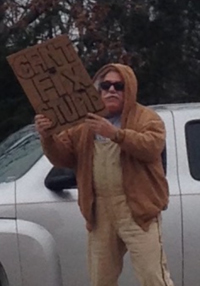 Then there was Rosebud, a tiny town—407 people living on barely more than two square miles. Still fifty-three miles east of Jefferson City, we approached Rosebud around noon on December 3 and learned that local law enforcement had refused to escort us through a mass of people blocking the road. “They are on their own in this county,” Sherriff Randy Esphorst told the Gasconade County Republican. “We will not escort. We will just sit and observe.”
Then there was Rosebud, a tiny town—407 people living on barely more than two square miles. Still fifty-three miles east of Jefferson City, we approached Rosebud around noon on December 3 and learned that local law enforcement had refused to escort us through a mass of people blocking the road. “They are on their own in this county,” Sherriff Randy Esphorst told the Gasconade County Republican. “We will not escort. We will just sit and observe.”
“We’re marching through,” Brooks told us, “whether they do their jobs or not.”
Esphorst turned out to be more bluster than conviction. After two hours of negotiation with Brooks, he stationed a squad car at both the front and rear of our procession. Our own instructions were to walk in twos, linking arms, and not to take photos or speak to protestors. “This is a silent march,” Brooks said. “Do not do anything to provoke them.” If we encountered physical violence, we were supposed to board the bus. The only problem: the deal with Esphorst had the bus parked at the end of town. Images of Selma flashed through my mind. My marching partner was Kennesaw University professor Jillian Ford, and we promised to take care of one another if violence broke out.
We had just passed a “Welcome to Rosebud” banner when a voice boomed, “All this for a thug and a thief! A thug and a thief!” And the crowd erupted.
I’d put my phone in my pocket as instructed. Thankfully, fellow marchers Jahi Assi and Quincy Bates had not. The footage they took—and my photo of a woman holding a sign that reads “All this for one Dead Nigger”—reveals a side of America that many of us (many white people, that is) believed was long gone. A few nights later, I met a retired police officer at a bar around the corner from the Governor’s Mansion. “It took a lot of guts to walk through Rosebud like that,” he said. “I’m not sure I could have done it. You guys were lucky no one got shot.”
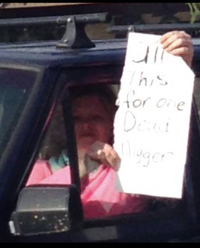 The moment the full group arrived at the bus on the far end of town, it was time for the sprint team to move ahead and make up for lost time. We’d already done the five-mile leg into Rosebud; being asked to get across the Gasconade River, seventeen miles down the road, in less than four hours seemed impossible. But those of us who were sprinting, including Brooks and NAACP Director of Digital Media Jamiah Adams, were thankful. We’d rather keep marching than try to process what had happened back in Rosebud.
The moment the full group arrived at the bus on the far end of town, it was time for the sprint team to move ahead and make up for lost time. We’d already done the five-mile leg into Rosebud; being asked to get across the Gasconade River, seventeen miles down the road, in less than four hours seemed impossible. But those of us who were sprinting, including Brooks and NAACP Director of Digital Media Jamiah Adams, were thankful. We’d rather keep marching than try to process what had happened back in Rosebud.
Three miles into the sprint, we learned that the white New York City police officer who had killed Eric Garner, another unarmed black man, on July 17 would not be indicted. The same day, twelve-year-old Tamir Rice, a black child killed by yet another white cop, was laid to rest.
When we crossed the Gasconade River, a hundred miles west of the place where Michael Brown died, Jonathan McKinney practically had to carry me onto the bus. Fifteen hours later, he was kicking me awake on the gym floor of Lincoln University, and we were off at five a.m. to evade the KKK.
Several hundred strong, marching through fog, we finally entered the state capital. It was 12:55 p.m., five minutes ahead of schedule. How we’d managed to march 135 miles through a beautiful yet rugged landscape, past often-hostile protestors, and still arrive at the state capital on time, I’ll never know.
I’ve been asked more times than I can count why I marched with the NAACP. Friends wondered if I believe Michael Brown was really innocent. Marchers wondered why a white poet from Denver would make such a journey. Here’s what I posted on Facebook the day before I ever heard of the Journey for Justice:
Goddamn, I’m so disappointed in us. In the legal system. In the justice system. In my friends and countrymen and women calling protestors “animals.” In all the hard work and loss of life that has come from this struggle. For all we’ve gone through as a nation to try to make ourselves better and to arrive at…this. This. Of all places I thought I’d be in my life as an American in the twenty-first century, I’ve always known this was possible but always believed we were better. Where did we go so wrong? And good god what can we do?
The next afternoon, on Thanksgiving, I had made a plan and clarified my own thoughts a bit. I believed the government’s response to protests in Ferguson—and across the country—are a serious threat to our democracy. I believed the laws of our land no longer serve and protect the people. The heart of the issue, I thought, was about being an American. Not about being black or white. Not about good cops or bad cops. This wasn’t an issue of race for me. It was about the laws of our land and how we enforce them and what we do when a police officer goes rogue.
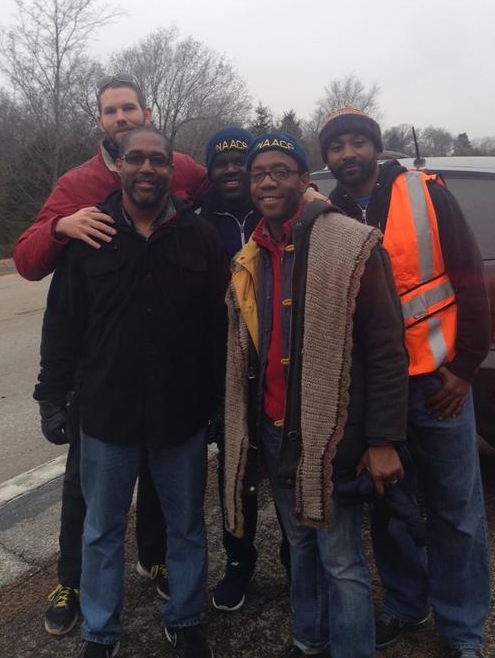 Joining the Journey for Justice changed my thinking. What’s going on in this country right now is as much about race as it is about the militarization of our police forces, as much about race as it is about due process, as much about race as it is about the relationship between law enforcement and the public. It’s as much about race as it is about democracy itself. I don’t know what happened to Michael Brown. Only Darren Wilson knows that. Without an indictment, without due process, we have no way to get at the truth.
Joining the Journey for Justice changed my thinking. What’s going on in this country right now is as much about race as it is about the militarization of our police forces, as much about race as it is about due process, as much about race as it is about the relationship between law enforcement and the public. It’s as much about race as it is about democracy itself. I don’t know what happened to Michael Brown. Only Darren Wilson knows that. Without an indictment, without due process, we have no way to get at the truth.
Since leaving my brothers and sisters on the march, I’ve found myself crying behind my sunglasses whenever I wonder whether I’ll ever see my fellow marchers again—and whenever I think of Michael Brown, Martin Luther King Jr., Tamir Rice, Malcolm X, Eric Garner, Emmett Till, John Crawford. The list goes on.
But then I remember that most of our fears on the march never came true, that ninety-nine percent of law-enforcement officers do their jobs well. Sherriff Michael Dixon of Linn, Missouri, is a great example. When he learned about what happened in Rosebud, he said, “I got on the local news and made it clear that wasn’t happening here, not in Linn.” And let’s not forget that even the citizens of Rosebud, and those of numerous other towns along our route, were exercising their rights just like us—and they did so without violence.
I do not hate them. I do not even dislike them. I feel sorry for them. To hate racists is to hate ourselves. As Floyd Lakenn Johnson, fellow marcher and professor of molecular biology at Pontifical Catholic University of Rio de Janeiro, told me on the way to the Ferguson Police Station my first night on the march: “We are a racist nation. Whites and blacks are raised on racism.”
None of us is free of this plague. It has visited all of our houses.

Copyright (c) 2014 by Andrew McFadyen-Ketchum. All rights reserved. McFadyen-Ketchum is the author of Ghost Gear, a finalist for the Miller Williams Prize in poetry from the University of Arkansas Press. He is also the editor of Apocalypse Now: Poems and Prose from the End of Days, the Floodgate Poetry Series, and PoemoftheWeek.org. A Nashville native, he teaches writing in Denver, Colorado.
